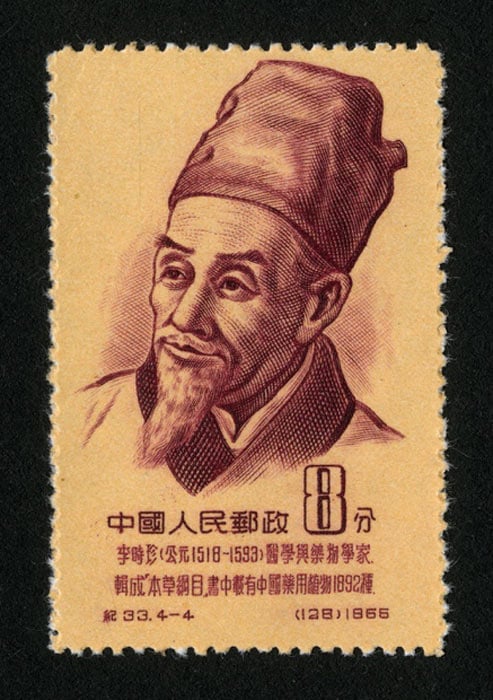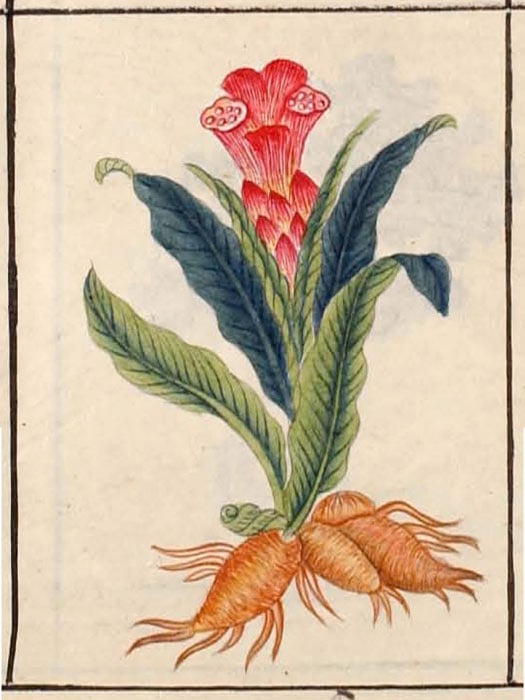The Ben Cao Gang Mu , or Compendium Materia Medica , is an encyclopedic compendium written by the 16th-century Chinese doctor Li Shizhen. This compilation is said to be the most complete and comprehensive medical book ever written in the history of traditional Chinese medicine , bringing together the medical knowledge of East Asia.

1955 stamp depicting Li Shizhen, the author of the Ben Cao Gang Mu, or Compendium Materia Medica. ( Public domain )
The Prince of Pharmacists and the Ben Cao Gang Mu
Although he remains almost entirely unknown in Western culture, Harvard Magazine explains that in China Li Shizhen “is virtually a household name” and a “kind of patron saint of Chinese herbal medicine.” Dubbed the Prince of Pharmacists, this scholar from the Hubei province in central China lived between 1518 and 1593 during the Ming Dynasty (1368 to 1644), investing the last half of his life researching and writing his most important work, the Ben Cao Gang Mu . Unfortunately, he died before it was published, and it was thanks to his sons and grandsons that the famed treatise was published in 1596.
This incredible piece of work, which contains 52 volumes, took 27 years to complete. It’s jam-packed with information taken from a wide range of contemporary sources. It includes descriptions, poems, histories, and recipes and remedies for using everything you can imagine as a medicine, from turtles and ginseng, to shellfish and human body parts. There are descriptions of 1,094 herbs, as well as hundreds of animal and mineral substances. In fact, this fabulous medicinal book includes 1,892 drugs and 11,096 prescriptions. It also contains hundreds of exquisite hand drawn diagrams.
Besides being a book on medicine, the Ben Cao Gang Mu also deals with natural history, giving a classification of mineral, vegetable, and animal products. If this were not enough, it includes chapters on chemical and industrial technology, as well as geographical, historical, dietetic, culinary, cosmological, philosophical, and philological data.

A page from the Ben Cao Gang Mu, or Chinese materia medica, with six types of shellfish and their medical uses. ( Public domain )
The Importance of the Ben Cao Gang Mu
In 2011, the Ben Cao Gang Mu received global recognition when it was included in UNESCO’s Memory of the World Register. A copy of the compendium that was block-printed in 1593 by Hu Cheng-Long in Jinling (modern Nanjin city in Jiansu Province, China), is kept in the Library of the China Academy of Chinese Medical Sciences. But, why is the Ben Cao Gang Mu so important?
It has been claimed that this piece of work, and the empirical approach employed by Li in his research and fieldwork have profoundly influenced the development and study of modern natural science. For instance, classification standards and the way materia medica should be compiled and formatted were laid down for the first time. This has been crucial in enhancing the credibility, scientific value, and accuracy of the biological classification of both flora and fauna.
Its importance is also evident in the fact that it has been translated into all the languages of the Far East, as well as the principal Western languages. Despite being over 400 years old, the Ben Cao Gang Mu is still being used as a monumental reference work. Thus, the longevity of this work and its influence beyond the borders of its land of origin demonstrates that this was an incredible achievement.

Illustration based on the Ben Cao Gang Mu by Li Shizhen. ( Public domain )
Nothing is Perfect: Factual Errors in the Ben Cao Gang Mu
Nevertheless, there are some notable factual errors in the Ben Cao Gang Mu . For instance, lead was claimed to be non-toxic, otters were apparently “always male,” and the Moupin langur, or golden snub-nosed monkey, were 10 feet (3 m) tall, had backwards feet and could be caught when it drew its upper lip over its eyes.
These errors, however, may be attributed to the limitations of scientific and technical knowledge at the time Li Shizhen wrote his famed medical book. Fortunately, they have been corrected. I suppose this demonstrates the cumulative nature of human knowledge, which one generation builds upon the achievements of its predecessors. It is this process of accumulation that has allowed us to attain the technological progress that we enjoy today.
Taking its name from the original masterpiece, the Ben Cao Gang Mu was performed by the popular Taiwanese singer Jay Chow on his album Still Fantasy . While its lyrics deal with Chinese pride, the aspect of the song I found most amusing was that Jay Chow rapped his way through the references to Chinese herbal medicine ! So, anyone up for rapping Pliny’s Natural History ?
Top image: The Ben Cao Gang Mu (Compendium of Material Medica) is a 16th-century collection of medical knowledge. Source: Public domain
By Ḏḥwty
Related posts:
Views: 0
 RSS Feed
RSS Feed















 April 13th, 2022
April 13th, 2022  Awake Goy
Awake Goy  Posted in
Posted in  Tags:
Tags: 
















